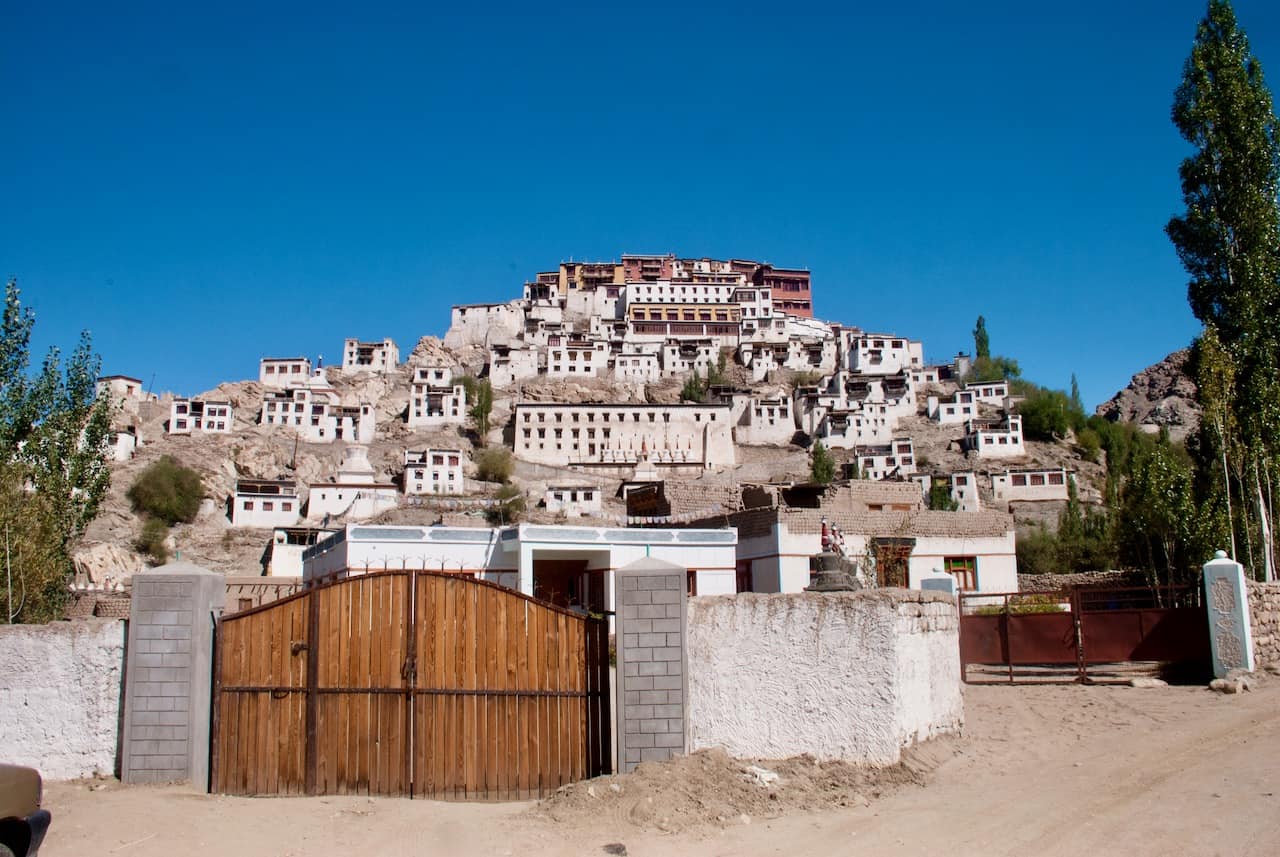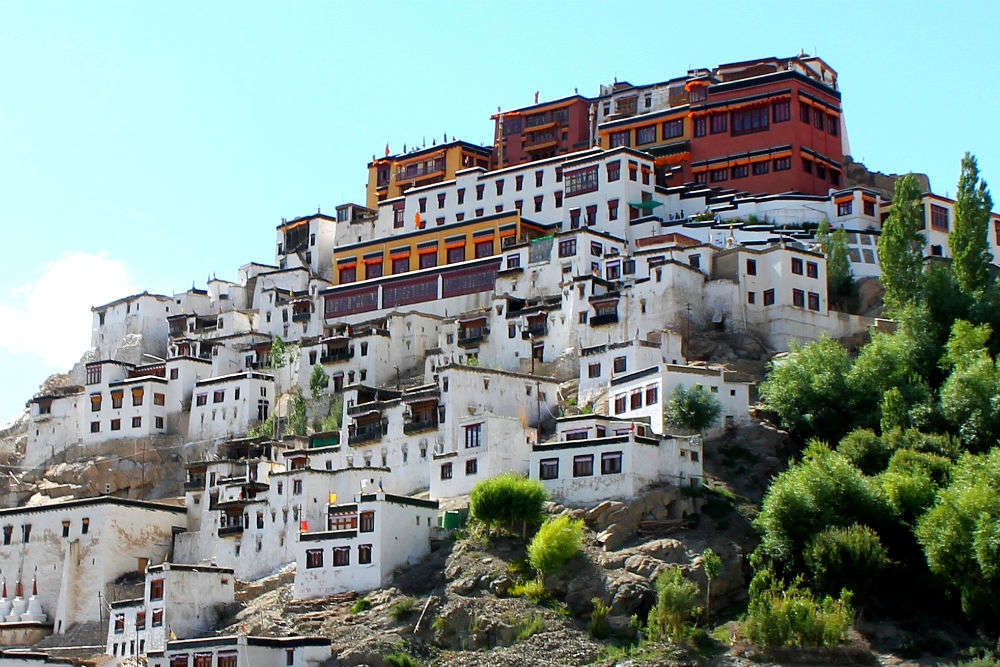Thiksey Monastery leh ladakh
Published on August 23, 2025
Thiksey Monastery is a magnificent and sprawling Buddhist monastery located in the heart of the Indus Valley in Ladakh. It is famously perched on a hilltop, and its stunning, layered architecture makes it look almost like a smaller version of the famous Potala Palace in Lhasa, Tibet. This resemblance has earned it the nickname "Mini Potala of India." More than just a beautiful building, Thiksey is a living center of Gelugpa Buddhism, a repository of ancient art, and a place of deep spiritual significance for the people of Ladakh. Its story is one of faith, perseverance, and a rich connection to the larger history of Tibetan Buddhism.
The Origin and a Legend of the Crow
The history of Thiksey Monastery goes back to the early 15th century. It belongs to the Gelugpa school of Tibetan Buddhism, which is often called the "Yellow Hat" sect. This school was founded by the great Tibetan scholar and spiritual master, Je Tsongkhapa. Tsongkhapa sent his students to various parts of Tibet to spread his teachings, and one of his disciples, Jangsem Sherab Zangpo, came to Ladakh.
Sherab Zangpo first built a small monastery called Lhakhang Serpo (which means "Yellow Temple") in a nearby village called Stagmo. Years later, he was succeeded by his nephew, Palden Zangpo, who continued his work. According to a very old and famous legend, Palden Zangpo and his teacher were performing a sacred ritual at their monastery. As part of the ritual, they had a special offering cake called a "torma." They were just about to throw the torma into the valley as a religious offering when a crow flew down, took the torma, and flew away with it.
They were shocked, but they believed the crow was a sign from the heavens. They followed the crow's flight path. A few kilometers away, they found the torma placed on a hilltop, completely untouched and in perfect order. They saw this as a very powerful and auspicious sign. They believed that this was the perfect, sacred place to build a new and larger monastery. And so, in the mid-15th century, the great monastery of Thiksey was established on that very hill. The name "Thiksey" is said to come from the local word that means "in perfect order," referring to the way the crow had placed the offering cake.
Over the centuries, the monastery grew in size and importance. The kings of the Namgyal dynasty of Ladakh supported it, adding new buildings and donating precious items. Thiksey became a major center for Buddhist learning and rituals, and it came to control several other smaller monasteries in the region.
The Architecture: A Mountain of Shrines
What makes Thiksey Monastery so unique is its striking architecture. The entire complex is built in a terraced, step-like fashion, climbing up the side of a hill. It is a brilliant example of traditional Ladakhi and Tibetan architecture. The buildings are all painted in white and have red and yellow stripes, which are the colors of the Gelugpa order. This multi-layered structure gives the monastery its famous resemblance to the Potala Palace in Lhasa.
The monastery is not just one building, but a complex of many different structures, each with its own purpose. The lowest part of the hill has the living quarters for the monks. As you climb up, you pass by smaller shrines and stupas (religious monuments). The most important and sacred buildings are located at the very top, closest to the heavens.
The main assembly hall, or Dukhang, is one of the most significant buildings. This is where the monks gather for daily prayers and rituals. The hall is beautifully decorated with ancient murals and "thangkas" (religious paintings on cloth). The walls tell stories from the life of the Buddha and other important figures. The atmosphere inside is calm and filled with the scent of incense and the low hum of chanting.
One of the most famous parts of the monastery is the Maitreya Temple. This temple was built in 1980 to honor the visit of the 14th Dalai Lama in 1970. It is a magnificent two-story building that houses a giant, 15-meter-tall statue of Maitreya Buddha, also known as the "Future Buddha." This statue is the largest of its kind in Ladakh. It is so big that it extends through two floors. Visitors can see the lower part of the statue from the ground floor and then climb up to a balcony to see the upper body and face. The statue is a powerful symbol of hope and future enlightenment for the Buddhist people.
Another important shrine is the Tara Temple, which is dedicated to the goddess Tara. This temple has 21 small statues of Tara, each in a different form, and is a place of peace and devotion. There is also a special temple for the guardian deities, called the Gonkhang, which is very important in protecting the monastery and its people.
From the top of the monastery, you get a breathtaking panoramic view of the Indus Valley. You can see the green fields of the villages below, the winding Indus River, and the rugged, snow-capped mountains of the Stok Range in the distance. This incredible view makes the long climb up worth every step.

The Living Heart of a Religion
Thiksey is not just a museum or a tourist spot. It is a living, breathing religious center. It is home to hundreds of monks and nuns who follow a very strict routine of daily prayers, meditation, and study. The best time to visit the monastery is early in the morning, around 6 a.m., when the monks gather for their morning prayer ceremony. The chanting of the monks, the sound of the trumpets and cymbals, and the serene atmosphere create an unforgettable experience for visitors.
The monastery also has a very active role in the local community. It runs a nunnery for female religious practitioners and provides education and support for them. This is an important part of its work, as in the past, nuns did not have the same opportunities as monks.
Thiksey also hosts a number of important festivals throughout the year. The most famous is the Thiksey Gustor Festival, which takes place in October or November. This two-day festival is celebrated with great enthusiasm and involves special rituals and the famous "Cham" dance. The Cham dance, performed by monks in colorful costumes and masks, tells stories from Buddhist scriptures and symbolizes the victory of good over evil. It is a very powerful and spiritual event that attracts pilgrims from all over the region.
In conclusion, Thiksey Monastery is a place of immense beauty, history, and spirituality. Its unique architecture, the famous legend of the crow, the magnificent Maitreya Buddha statue, and the living tradition of its monks all come together to make it one of the most important and beautiful monasteries in Ladakh. It is a place that shows the deep-rooted faith of the people of the region and offers a powerful glimpse into the heart of Tibetan Buddhism.

